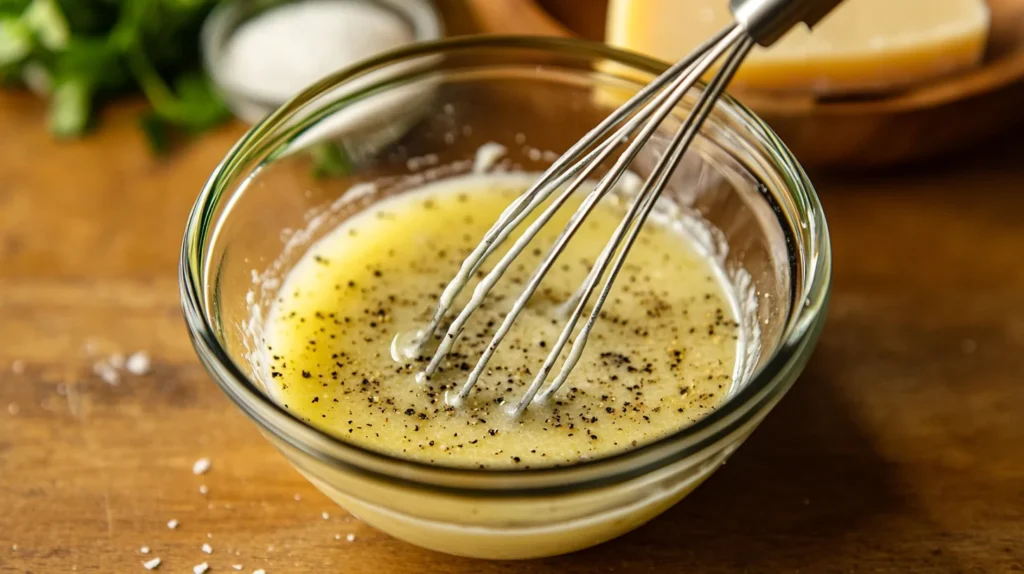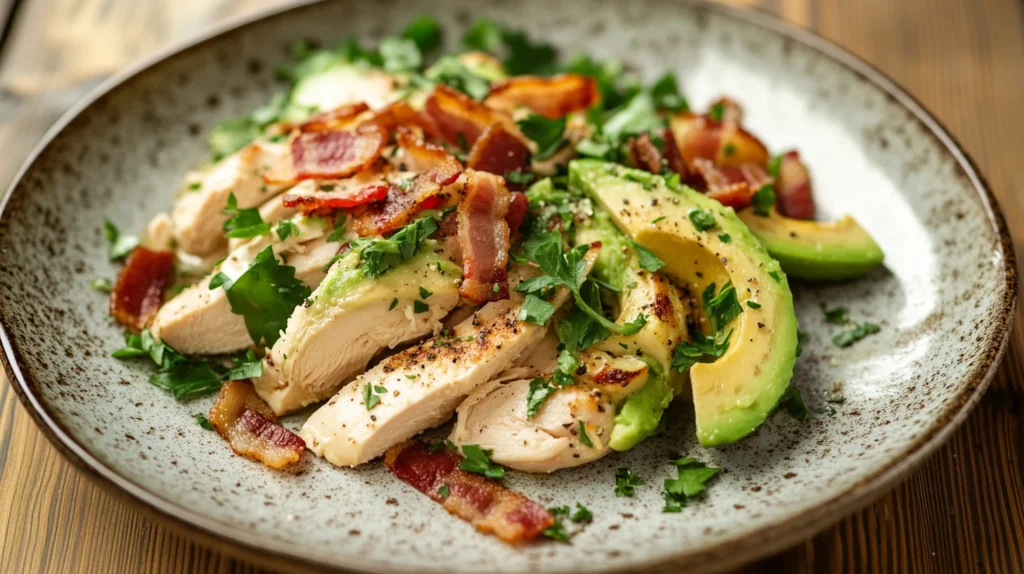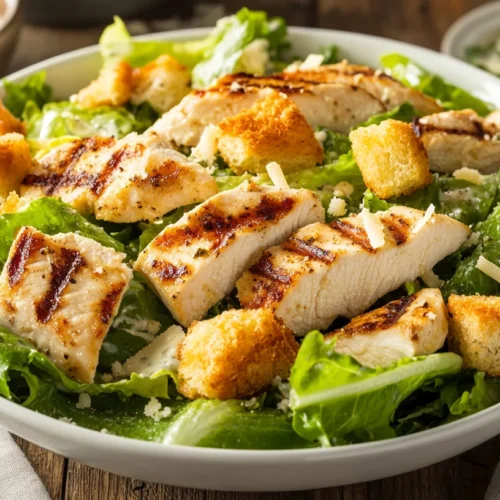Chicken Caesar Salad is a timeless dish loved by millions worldwide for its combination of flavors and textures. With tender grilled chicken, crispy romaine lettuce, crunchy croutons, tangy Parmesan cheese, and creamy Caesar dressing, it strikes the perfect balance between indulgence and nutrition. But how did this iconic dish come to be, and what makes it so special?
In this article, we’ll explore the history, nutritional benefits, and preparation of Chicken Caesar Salad, along with creative variations and tips for making it at home. Whether you’re a seasoned cook or a beginner, this guide will help you craft the perfect salad for any occasion.

Why Chicken Caesar Salad Is a Popular Choice
The Chicken Caesar Salad’s roots trace back to the original Caesar Salad, a dish invented in the early 1920s by Italian-American chef Caesar Cardini. Contrary to popular belief, this salad did not originate in Italy but in Tijuana, Mexico, where Cardini operated a restaurant. The legend goes that during a busy Fourth of July weekend, Cardini improvised the dish with ingredients he had on hand, creating a masterpiece of simplicity and flavor.
The original Caesar Salad comprised romaine lettuce, garlic, croutons, Parmesan cheese, olive oil, egg, Worcestershire sauce, and lemon juice. The absence of chicken in the initial recipe may surprise some, as the addition of grilled chicken came later to increase the salad’s protein content and versatility, transforming it into a more substantial meal.
Over time, the Chicken Caesar Salad gained global fame, becoming a go-to option in restaurants and homes alike. Its versatility and ability to cater to different tastes make it an enduring favorite.
Nutritional Benefits
Macronutrient Content
One of the reasons Chicken Caesar Salad is so beloved is its nutritional profile. It combines protein, healthy fats, and fiber, making it a balanced meal option. Grilled chicken provides a lean source of protein, essential for muscle repair and overall health. A single serving of the salad can contain anywhere from 20 to 40 grams of protein, depending on the portion size and ingredients.
Vitamins and Minerals
Romaine lettuce, the base of the salad, is rich in vitamins A, C, and K, as well as folate and potassium. These nutrients play critical roles in maintaining skin health, boosting immunity, and supporting bone strength. Parmesan cheese contributes calcium and phosphorus, which are essential for bone health, while the dressing and olive oil supply healthy monounsaturated fats and antioxidants.
The Salad’s Role in a Healthy Diet
Chicken Caesar Salad is versatile enough to fit into various diets. It can be customized to be low-carb, high-protein, or even gluten-free by adjusting the croutons or dressing. While the salad can be calorie-dense due to the cheese and dressing, portion control and ingredient modifications make it a healthy option for most people.
Essential Ingredients for a Classic Chicken Caesar Salad
To make a delicious Chicken Caesar Salad, it’s important to understand its core ingredients and how each contributes to the dish’s flavor and texture. From the crisp greens to the creamy dressing, every component has a role to play in crafting the perfect salad.
The Star Ingredient – Grilled Chicken
Grilled chicken is the centerpiece of a Chicken Caesar Salad, providing lean protein and a savory flavor. The chicken can be seasoned with simple salt and pepper or marinated with garlic, lemon, and herbs for a more robust taste. Grilling or pan-searing the chicken ensures a smoky, caramelized exterior while keeping the meat tender and juicy.
- Tips for Perfect Chicken:
- Ensure the chicken is cooked to an internal temperature of 165°F (75°C) for safety.
- Slice the chicken into thin strips or bite-sized pieces for easy mixing and eating.
The Greens – Crisp Romaine Lettuce
Romaine lettuce serves as the foundation of the salad. Its sturdy, crisp texture and mildly sweet flavor make it an ideal base. Unlike delicate greens, romaine holds up well against the creamy Caesar dressing, ensuring every bite is satisfying.
- Why Romaine Lettuce?
- High in water content, keeping the salad refreshing.
- Rich in dietary fiber, aiding digestion.
- Packed with nutrients like vitamin A and potassium.
For the best results, wash and dry the lettuce thoroughly to remove grit and excess moisture, which can dilute the dressing. Tear the leaves into bite-sized pieces for even distribution.
The Creamy Caesar Dressing
The dressing is what truly defines a Caesar Salad.
- Garlic
- Anchovies (or anchovy paste)
- Egg yolk
- Dijon mustard
- Lemon juice
- Olive oil
- Worcestershire sauce
This mixture creates a tangy, umami-rich sauce that coats every ingredient perfectly. Modern variations may include mayonnaise for added creaminess or Greek yogurt for a lighter, healthier twist.
- Pro Tip: For a fresh flavor, make the dressing from scratch. Pre-made dressings are convenient but may lack the depth of a homemade version.
The Crunch – Croutons
Croutons add a delightful crunch to the salad, balancing the creamy dressing and soft greens. These small, toasted bread cubes are often seasoned with garlic, herbs, and olive oil. Making croutons at home is simple and allows for customization:
- Use stale bread, such as sourdough or baguette, for the best texture.
- Cut the bread into evenly sized cubes, toss with olive oil and seasonings, and bake until golden brown.
The Cheese – Parmesan
No Chicken Caesar Salad is complete without Parmesan cheese. Its sharp, nutty flavor pairs beautifully with the dressing and chicken. Use freshly grated or shaved Parmesan for the best taste and presentation. Avoid pre-grated varieties, which may contain additives that affect texture and flavor.
Making Chicken Caesar Salad at Home
Creating a Chicken Caesar Salad at home is a rewarding experience that allows you to control the quality and freshness of your ingredients. By following a step-by-step process, you can replicate restaurant-quality results in your kitchen.

Ingredient Preparation
1. Preparing the Chicken
- Selection and Seasoning: Choose fresh boneless, skinless chicken breasts or thighs. Season with salt, pepper, garlic powder, and a drizzle of olive oil. For extra flavor, marinate the chicken with lemon juice, minced garlic, and herbs like rosemary or thyme for 30 minutes before cooking.
- Cooking Method: Grill the chicken for a smoky taste, pan-sear for crispy edges, or bake for a hands-off option. Cook until the internal temperature reaches 165°F (75°C). Allow the chicken to rest for a few minutes before slicing into thin strips or chunks.
2. Preparing the Romaine Lettuce
- Washing and Drying: Separate the leaves, wash thoroughly under cold water, and dry with a salad spinner or kitchen towel.
- Cutting: Tear or chop the lettuce into bite-sized pieces, ensuring they’re uniform for even distribution.
3. Preparing the Dressing
- Ingredients: Combine the following in a blender or bowl:
- 2 garlic cloves, minced
- 2 anchovy fillets or 1 tsp anchovy paste
- 1 egg yolk
- 1 tsp Dijon mustard
- 1 tbsp fresh lemon juice
- 1/2 cup olive oil (slowly added for emulsification)
- 1/4 cup grated Parmesan cheese
- Dash of Worcestershire sauce
- Salt and pepper to taste
- Blending: Blend or whisk until smooth and creamy. Adjust seasoning to your taste.
4. Making the Croutons
- Ingredients: Use day-old bread, olive oil, garlic powder, and dried herbs like oregano or parsley.
- Method: Cut the bread into cubes, toss with olive oil and seasonings, and bake at 375°F (190°C) for 10-15 minutes, turning occasionally until golden and crisp.
Assembling the Salad
Step-by-Step Assembly
- Layer the Greens: Place the prepared romaine lettuce in a large salad bowl as the base.
- Add the Chicken: Arrange the grilled chicken slices evenly across the lettuce.
- Drizzle the Dressing: Spoon or drizzle the homemade Caesar dressing over the salad. Use just enough to coat the greens lightly, reserving extra for serving.
- Top with Croutons and Cheese: Sprinkle the croutons and freshly grated or shaved Parmesan cheese on top for texture and flavor.
- Toss and Serve: Gently toss the salad just before serving to ensure every bite is flavorful. Serve immediately.
Tips for Success
- Keep Ingredients Fresh: Use fresh lettuce, high-quality olive oil, and freshly grated Parmesan for the best results.
- Customize the Dressing: Adjust the tanginess or creaminess of the dressing by adding more lemon juice or olive oil.
- Make Ahead: You can prepare the components in advance (cook the chicken, make the croutons, and blend the dressing) and assemble the salad just before serving.
Variations of Chicken Caesar Salad
While the classic Chicken Caesar Salad is undeniably delicious, experimenting with variations can add new flavors, textures, and nutritional profiles. Whether you’re catering to dietary restrictions or looking for a creative twist, these options ensure there’s something for everyone.

Adding Extra Flavor with Creative Twists
1. Avocado Chicken Caesar Salad
- Why Add Avocado? The creamy texture of avocado complements the tangy Caesar dressing while adding heart-healthy monounsaturated fats.
- How to Incorporate: Slice a ripe avocado and layer it alongside the chicken for a rich and indulgent variation.
2. Bacon Chicken Caesar Salad
- Why Add Bacon? Crispy bacon adds a smoky, salty contrast to the salad, enhancing its flavor profile.
- How to Incorporate: Crumble cooked bacon over the salad before serving. For a healthier twist, use turkey bacon.
3. Grilled Vegetables Caesar Salad
- Why Add Grilled Veggies? Grilled vegetables like zucchini, bell peppers, or asparagus introduce a smoky and slightly sweet element.
- How to Incorporate: Toss the grilled vegetables with the lettuce and chicken before adding the dressing.
Dietary Adaptations
1. Vegetarian Caesar Salad
- How to Make It Vegetarian:
- Replace chicken with roasted chickpeas or tofu for a plant-based protein option.
- Use a vegetarian-friendly Caesar dressing by substituting anchovies with capers or miso paste for umami flavor.
2. Vegan Caesar Salad
- How to Make It Vegan:
- Replace chicken with tempeh, grilled mushrooms, or a plant-based protein alternative.
- Use a vegan Caesar dressing made with cashews, nutritional yeast, lemon juice, garlic, and olive oil.
- Substitute Parmesan with a vegan cheese alternative or a sprinkle of nutritional yeast.
Adjusting for Specific Lifestyles
1. Low-Calorie Caesar Salad
- How to Make It Lighter:
- Grill chicken without oil and reduce the amount of dressing used.
- Opt for a dressing made with Greek yogurt instead of mayonnaise or egg yolks.
- Use air-fried croutons or omit them entirely.
2. Keto Caesar Salad
- How to Make It Keto-Friendly:
- Skip the croutons or use low-carb almond flour crackers.
- Increase the amount of chicken and dressing to boost fat and protein content.
3. Gluten-Free Caesar Salad
- How to Make It Gluten-Free:
- Replace traditional croutons with gluten-free bread or omit them altogether.
- Ensure the dressing ingredients, such as Worcestershire sauce, are gluten-free.
Global-Inspired Variations
1. Asian-Style Caesar Salad
- Use sesame oil in the dressing, add shredded carrots, and top with sesame seeds or crispy wontons.
2. Spicy Chicken Caesar Salad
- Toss the chicken in chili powder or hot sauce before grilling to add a kick of spice.
Seasonal Variations
- Spring Caesar Salad: Add fresh peas, radishes, and microgreens for a seasonal touch.
- Fall Caesar Salad: Incorporate roasted butternut squash or sweet potatoes for warmth and sweetness.
With endless possibilities, the Chicken Caesar Salad can be adapted to suit any preference or occasion, making it a versatile and creative culinary delight.
Serving Suggestions
The way you serve Chicken Caesar Salad can elevate the dining experience, whether it’s a casual lunch or a formal dinner. Here are some ideas to make your salad shine:
Presentation Tips
- Layering for Visual Appeal: Arrange the lettuce, chicken, and toppings in layers rather than mixing everything at once. This creates an Instagram-worthy presentation.
- Individual Servings: Serve the salad in bowls or plates, pre-portioned for each guest, to make it look polished.
- Garnishes: Add a final touch with freshly shaved Parmesan, cracked black pepper, or a sprinkle of fresh parsley.
Serve with a Mini Donuts dessert to round out your meal.
Pairing Suggestions with:
Drinks: A crisp white wine like Sauvignon Blanc or a refreshing iced tea pairs beautifully with the salad.
Soups: Pair the salad with a light soup like tomato basil or minestrone for a comforting meal.
Bread: Serve alongside warm garlic bread, focaccia, or a crusty baguette to complement the crisp greens.
Pair Your Salad with Other Dishes
If you’re looking for complementary dishes, you might enjoy a Burrata Salad for a creamy and fresh addition to your menu. For seafood lovers, a Shrimp Salad Recipe makes an excellent pairing with the chicken Caesar salad, offering a delightful balance of flavors.
Frequently Asked Questions
Is a Chicken Caesar Salad Healthy?
Yes, a Chicken Caesar Salad can be healthy when prepared with fresh, wholesome ingredients and portion control in mind. It provides a good balance of protein (from chicken), healthy fats (from olive oil in the dressing), and essential vitamins and minerals (from romaine lettuce and Parmesan cheese). However, the salad can become calorie-dense due to the dressing and croutons. To make it lighter, use a low-fat dressing, fewer croutons, or substitute them with healthier options like roasted chickpeas.
Why Do People Love Caesar Salad?
People love Caesar Salad because of its combination of textures and flavors. The crisp romaine lettuce, creamy dressing, savory Parmesan cheese, and crunchy croutons create a balanced and satisfying eating experience. Its simplicity and versatility make it a popular choice, as it can be enjoyed as a side dish or a main course with added protein like chicken.
What Is the Nickname for the Caesar Salad?
The Caesar Salad is often affectionately referred to as “Caesar” in casual dining settings. Some might also call it “Cardini’s Salad” in honor of its creator, Caesar Cardini.
Which Ingredient Is Not Commonly Found in a Caesar Salad?
Tomatoes are not commonly found in a traditional Caesar Salad. While some modern recipes include them for added color and flavor, the original Caesar Salad relies on romaine lettuce, Parmesan cheese, croutons, and Caesar dressing as its primary components.
Conclusion
Chicken Caesar Salad stands out as a dish that combines simplicity, flavor, and nutrition in one bowl. Its crisp greens, tender chicken, and creamy dressing make it a versatile option for any meal. Whether you stick to the classic recipe or experiment with creative variations, this salad offers endless possibilities to suit your taste and dietary preferences.
So, the next time you’re looking for a quick yet satisfying meal, remember that a Chicken Caesar Salad can be your go-to choice. With fresh ingredients and a little preparation, you’ll have a dish that’s as delicious as it is nutritious.

Classic Chicken Caesar Salad – A Crisp and Creamy Favorite
Equipment
- Large mixing bowl
- Whisk for dressing
- Cutting board
- Sharp knife
- Grill pan or skillet (for cooking the chicken)
- Measuring cups and spoons
- Tongs (for tossing the salad)
Ingredients
- ✅ For the Salad:
- 2 romaine lettuce hearts chopped
- 2 medium chicken breasts
- 1 tablespoon olive oil
- ½ teaspoon salt
- ½ teaspoon black pepper
- 1 teaspoon garlic powder
- 1 cup croutons
- ½ cup parmesan cheese shredded or shaved
- ✅ For the Caesar Dressing:
- ½ cup mayonnaise
- ¼ cup parmesan cheese grated
- 2 tablespoons lemon juice
- 1 teaspoon Dijon mustard
- 1 teaspoon Worcestershire sauce
- 1 small clove garlic minced
- ½ teaspoon black pepper
- 2 tablespoons olive oil
Instructions
- 🔸 Step 1: Prepare the Chicken
- 1️⃣ Pat the chicken breasts dry with a paper towel.
- 2️⃣ Season both sides with olive oil, salt, black pepper, and garlic powder.
- 3️⃣ Heat a grill pan or skillet over medium heat.
- 4️⃣ Cook the chicken for 5–6 minutes per side until fully cooked.
- 5️⃣ Let the chicken rest for 5 minutes, then slice into thin strips.
- 🔸 Step 2: Make the Dressing
- 6️⃣ In a small bowl, whisk together mayonnaise, grated parmesan, lemon juice, Dijon mustard, Worcestershire sauce, garlic, and black pepper.
- 7️⃣ Slowly drizzle in the olive oil while whisking until smooth.
- 🔸 Step 3: Assemble the Salad
- 8️⃣ In a large mixing bowl, add chopped romaine lettuce, croutons, and sliced grilled chicken.
- 9️⃣ Pour the Caesar dressing over the salad and toss everything together until well coated.
- 🔟 Sprinkle with shaved parmesan cheese and serve immediately!
Notes
Crispy Chicken Option: Use breaded chicken cutlets instead of grilled chicken.
Dairy-Free Option: Omit the parmesan and use a dairy-free dressing alternative.
Meal Prep Friendly: Store ingredients separately and toss them together right before serving to keep the salad fresh.

